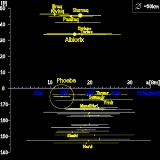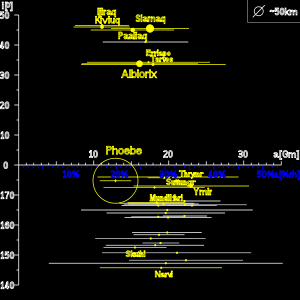
Saturn's Inuit group of satellites
Encyclopedia
The Inuit group is a dynamical grouping of the prograde
irregular satellite
s Saturn
which follow similar orbit
s. Their semi-major axes
range between 11 and 18 Gm, their inclination
s between 40° and 50°, and their eccentricities between 0.15 and 0.48.
 The diagram illustrates the Inuit group in relation to other irregular satellites of Saturn. The eccentricity of the orbits is represented by the yellow segments (extending from the pericentre
The diagram illustrates the Inuit group in relation to other irregular satellites of Saturn. The eccentricity of the orbits is represented by the yellow segments (extending from the pericentre
to the apocentre
) with the inclination represented on Y axis.
The five members of the group are (in order of increasing distance from Saturn):
The International Astronomical Union
(IAU) uses names taken from Inuit mythology
for these moons.
The group appeared quite homogenous in early observations, the satellites displaying light-red colour (colour indices
B−V = 0.79 and V−R = 0.51, similar to that of Gallic group
)
and similar infrared spectra.
Recent observations however, revealed that Ijiraq is distinctively redder than Paaliaq, Siarnaq and Kiviuq. In addition, unlike the other three, Ijiraq's spectrum does not display a weak absorption near 0.7 μm. This feature is attributed to a possible water
hydration
.
The spectral
homogeneity (with the exception of Ijiraq) is consistent with a common origin in the break-up of a single object but the dispersion of the orbital parameters requires further explanation.
Recently reported secular resonances among the members could provide the explanation of the post-collisional dispersion.
Prograde
Prograde can refer to:*Prograde or direct motion, in astronomy, a type of motion of astronomical bodies* Prograde metamorphism, in geology, describes mineral changes in rocks under increasing pressure and/or temperature conditions...
irregular satellite
Irregular satellite
In astronomy, an irregular moon is a natural satellite following a distant, inclined, and often eccentric and retrograde orbit. They are believed to have been captured by their parent planet, unlike regular satellites, which form in situ....
s Saturn
Saturn
Saturn is the sixth planet from the Sun and the second largest planet in the Solar System, after Jupiter. Saturn is named after the Roman god Saturn, equated to the Greek Cronus , the Babylonian Ninurta and the Hindu Shani. Saturn's astronomical symbol represents the Roman god's sickle.Saturn,...
which follow similar orbit
Orbit
In physics, an orbit is the gravitationally curved path of an object around a point in space, for example the orbit of a planet around the center of a star system, such as the Solar System...
s. Their semi-major axes
Semi-major axis
The major axis of an ellipse is its longest diameter, a line that runs through the centre and both foci, its ends being at the widest points of the shape...
range between 11 and 18 Gm, their inclination
Inclination
Inclination in general is the angle between a reference plane and another plane or axis of direction.-Orbits:The inclination is one of the six orbital parameters describing the shape and orientation of a celestial orbit...
s between 40° and 50°, and their eccentricities between 0.15 and 0.48.

Apsis
An apsis , plural apsides , is the point of greatest or least distance of a body from one of the foci of its elliptical orbit. In modern celestial mechanics this focus is also the center of attraction, which is usually the center of mass of the system...
to the apocentre
Apsis
An apsis , plural apsides , is the point of greatest or least distance of a body from one of the foci of its elliptical orbit. In modern celestial mechanics this focus is also the center of attraction, which is usually the center of mass of the system...
) with the inclination represented on Y axis.
The five members of the group are (in order of increasing distance from Saturn):
- KiviuqKiviuq (moon)Kiviuq is a prograde irregular satellite of Saturn. It was discovered by Brett J. Gladman in 2000, and given the temporary designation S/2000 S 5. It was named after Kiviuq, a hero of Inuit mythology....
- IjiraqIjiraq (moon)Ijiraq , or Saturn XXII , is small prograde irregular satellite of Saturn. It was discovered by the team ofBrett Gladman, John J. Kavelaars, et al. in 2000, and given the temporary designation '...
- PaaliaqPaaliaq (moon)Paaliaq is a prograde irregular satellite of Saturn. It was discovered by Brett J. Gladman, John J. Kavelaars, Jean-Marc Petit, Hans Scholl, Matthew J. Holman, Brian G. Marsden, Philip D. Nicholson and Joseph A. Burns in early October 2000, and given the temporary designation S/2000 S 2...
- SiarnaqSiarnaq (moon)Siarnaq , or Saturn XXIX, is a prograde irregular satellite of Saturn. It was discovered by Brett J. Gladman, et al. in 2000, and given the temporary designation S/2000 S 3....
- TarqeqTarqeq (moon)Tarqeq , also known as Saturn LII is a natural satellite of Saturn. Its discovery was announced by Scott S. Sheppard, David C. Jewitt, Jan Kleyna, and Brian G. Marsden on April 13, 2007, from observations taken between January 5, 2006, and March 22, 2007...
The International Astronomical Union
International Astronomical Union
The International Astronomical Union IAU is a collection of professional astronomers, at the Ph.D. level and beyond, active in professional research and education in astronomy...
(IAU) uses names taken from Inuit mythology
Inuit mythology
Inuit mythology has many similarities to the religions of other polar regions. Inuit traditional religious practices could be very briefly summarised as a form of shamanism based on animist principles....
for these moons.
The group appeared quite homogenous in early observations, the satellites displaying light-red colour (colour indices
Color index
In astronomy, the color index is a simple numerical expression that determines the color of an object, which in the case of a star gives its temperature...
B−V = 0.79 and V−R = 0.51, similar to that of Gallic group
Saturn's Gallic group of satellites
The Gallic group is a dynamical grouping of the prograde irregular satellites of Saturn following similar orbits. Their semi-major axes range between 16 and 19 Gm, their inclinations between 35° and 40°, and their eccentricities around 0.53....
)
and similar infrared spectra.
Recent observations however, revealed that Ijiraq is distinctively redder than Paaliaq, Siarnaq and Kiviuq. In addition, unlike the other three, Ijiraq's spectrum does not display a weak absorption near 0.7 μm. This feature is attributed to a possible water
Water
Water is a chemical substance with the chemical formula H2O. A water molecule contains one oxygen and two hydrogen atoms connected by covalent bonds. Water is a liquid at ambient conditions, but it often co-exists on Earth with its solid state, ice, and gaseous state . Water also exists in a...
hydration
.
The spectral
Electromagnetic spectrum
The electromagnetic spectrum is the range of all possible frequencies of electromagnetic radiation. The "electromagnetic spectrum" of an object is the characteristic distribution of electromagnetic radiation emitted or absorbed by that particular object....
homogeneity (with the exception of Ijiraq) is consistent with a common origin in the break-up of a single object but the dispersion of the orbital parameters requires further explanation.
Recently reported secular resonances among the members could provide the explanation of the post-collisional dispersion.

